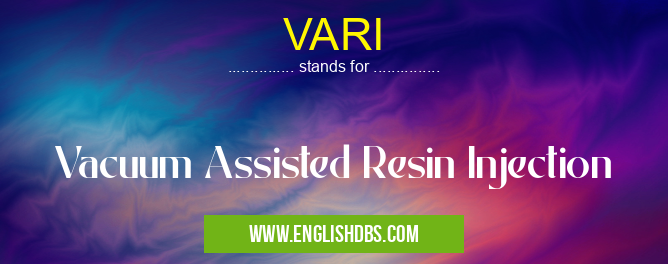What does VARI mean in UNCLASSIFIED
Vacuum Assisted Resin Injection (VARI) is a state-of-the-art technique used in the manufacturing of composite materials. It involves injecting resin into a mold under vacuum, ensuring optimal resin distribution and void reduction. VARI is widely employed in various industries, including aerospace, automotive, and marine, to produce high-quality composite components.

VARI meaning in Unclassified in Miscellaneous
VARI mostly used in an acronym Unclassified in Category Miscellaneous that means Vacuum Assisted Resin Injection
Shorthand: VARI,
Full Form: Vacuum Assisted Resin Injection
For more information of "Vacuum Assisted Resin Injection", see the section below.
Process of VARI
The VARI process consists of the following steps:
- Mold Preparation: The mold is carefully prepared to ensure a proper seal and prevent resin leakage.
- Lay-up of Reinforcements: Reinforcements, such as fiberglass or carbon fiber, are laid up in the mold according to the desired design.
- Vacuum Bagging: The mold is covered with a vacuum bag and sealed to create a vacuum environment.
- Resin Injection: Resin is injected into the mold under vacuum, filling the void spaces between the reinforcements.
- Curing: The resin is allowed to cure under controlled temperature and pressure, resulting in a solid composite structure.
Advantages of VARI
VARI offers numerous advantages over traditional composite manufacturing methods, including:
- Improved Resin Distribution: Vacuum assistance ensures even distribution of resin throughout the mold, reducing voids and improving material properties.
- Void Reduction: The vacuum environment eliminates air bubbles and other voids, resulting in a denser and stronger composite structure.
- Enhanced Surface Quality: VARI produces components with a smooth and defect-free surface finish.
- Reduced Material Waste: The controlled resin injection process minimizes material waste and optimizes material utilization.
Applications of VARI
VARI is widely used in the following applications:
- Aerospace: Fabrication of aircraft components, such as wings, fuselage, and engine nacelles.
- Automotive: Production of lightweight and high-performance automotive parts, including body panels, interior components, and structural reinforcements.
- Marine: Construction of boats, yachts, and other marine vessels with improved strength, durability, and weight reduction.
Essential Questions and Answers on Vacuum Assisted Resin Injection in "MISCELLANEOUS»UNFILED"
What is Vacuum Assisted Resin Injection (VARI)?
Vacuum Assisted Resin Injection (VARI) is a composite manufacturing technique that utilizes vacuum pressure to infuse resin into a fiber preform, creating a strong and lightweight composite structure. This process involves placing a preform, consisting of dry fibers, into a mold and applying a vacuum to extract air from the mold. Resin is then injected into the mold under vacuum, impregnating the fibers and creating a composite material.
What are the advantages of using VARI?
VARI offers several advantages, including:
- High fiber volume fraction, resulting in strong and stiff composites.
- Improved surface quality and reduced porosity.
- Reduced resin waste and lower environmental impact.
- Automation potential, enabling efficient and consistent production.
How does VARI differ from other composite manufacturing techniques?
Unlike other methods such as hand layup or spray-up, VARI utilizes vacuum pressure to draw the resin into the fiber preform. This results in better compaction and reduced voids, leading to improved mechanical properties. Additionally, VARI allows for the use of preforms with complex shapes, enabling the production of intricate composite structures.
What are the key steps involved in the VARI process?
The key steps in the VARI process are:
- Preform preparation: Dry fibers are cut and laid into a mold to form the desired shape.
- Vacuum bagging: A vacuum bag is placed over the preform and sealed to create a vacuum environment.
- Resin injection: Resin is injected into the mold under vacuum, impregnating the fibers.
- Curing: The resin is cured, either at room temperature or elevated temperatures, to form the composite structure.
What types of materials are suitable for VARI?
VARI is compatible with a wide range of materials, including:
- Carbon fibers
- Glass fibers
- Aramid fibers
- Natural fibers
- Thermosetting resins (e.g., epoxy, polyester, vinyl ester)
- Thermoplastic resins (e.g., PEEK, PEI)
What are the applications of VARI?
VARI is used in various industries, including:
- Aerospace: Production of aircraft components, such as wings and fuselage skins.
- Automotive: Fabrication of body panels, bumpers, and interior parts.
- Marine: Manufacturing of boat hulls, decks, and spars.
- Wind energy: Production of wind turbine blades.
- Medical: Creation of prosthetics, implants, and surgical devices.
Final Words: Vacuum Assisted Resin Injection (VARI) is a highly effective technique that revolutionizes the production of composite materials. By utilizing vacuum technology, VARI enhances resin distribution, reduces voids, improves surface quality, and minimizes material waste. Its versatility and advantages have made it an indispensable tool in various industries, leading to the development of high-performance and reliable composite components.
